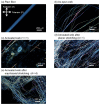Planar or Biaxial Stretching of Poly(ethylene terephthalate) Fiber Webs Prepared by Laser-Electrospinning
- PMID: 35329660
- PMCID: PMC8950323
- DOI: 10.3390/ma15062209
Planar or Biaxial Stretching of Poly(ethylene terephthalate) Fiber Webs Prepared by Laser-Electrospinning
Abstract
In this work, laser-heated electrospinning (LES) process using carbon dioxide laser was explored as an eco-friendly method for producing ultrafine fibers. To enhance the thinning of fibers and the formation of fiber structure, planar or equibiaxial stretching and subsequent annealing processes were applied to poly(ethylene terephthalate) (PET) fiber webs prepared by LES. The structure and properties of the obtained webs were investigated. Ultrafine fiber webs with an average diameter of approximately 1 μm and a coefficient of variation of 20-25% were obtained when the stretch ratios in the MD (machine direction) × TD (transverse direction) were 3 × 1 and 3 × 3 for the planar and equibiaxial stretching, respectively. In the wide-angle X-ray diffraction analysis of the web samples, preferential orientation of crystalline c-axis were confirmed along the MD for planar stretching and only along the web plane for equibiaxial stretching, which was in contrast to the stretching of film samples, where additional preferential orientation of benzene ring along the film plane proceeded. The results obtained suggest that PET fiber webs fabricated through LES and subsequent planar or biaxial stretching processes have potential for a wide variety of applications, such as packaging and battery separator materials.
Keywords: biaxial stretching; birefringence; crystallinity; melt electrospinning; planar stretching; poly(ethylene terephthalate); ultrafine fibers.
Conflict of interest statement
The authors declare no conflict of interest.
Figures











Similar articles
-
Structure and Properties of Poly(ethylene terephthalate) Fiber Webs Prepared via Laser-Electrospinning and Subsequent Annealing Processes.Materials (Basel). 2020 Dec 18;13(24):5783. doi: 10.3390/ma13245783. Materials (Basel). 2020. PMID: 33352872 Free PMC article.
-
Bamboo Charcoal/Poly(L-lactide) Fiber Webs Prepared Using Laser-Heated Melt Electrospinning.Polymers (Basel). 2021 Aug 18;13(16):2776. doi: 10.3390/polym13162776. Polymers (Basel). 2021. PMID: 34451314 Free PMC article.
-
Laser-Assisted Melt Electrospinning of Poly(L-lactide-co-ε-caprolactone): Analyses on Processing Behavior and Characteristics of Prepared Fibers.Polymers (Basel). 2022 Jun 20;14(12):2511. doi: 10.3390/polym14122511. Polymers (Basel). 2022. PMID: 35746087 Free PMC article.
-
A biaxially stretched cellulose film prepared from ionic liquid solution.Carbohydr Polym. 2021 May 15;260:117816. doi: 10.1016/j.carbpol.2021.117816. Epub 2021 Feb 15. Carbohydr Polym. 2021. PMID: 33712160
-
Effects of Interphase Modification and Biaxial Orientation on Dielectric Properties of Poly(ethylene terephthalate)/Poly(vinylidene fluoride-co-hexafluoropropylene) Multilayer Films.ACS Appl Mater Interfaces. 2016 Jun 1;8(21):13555-66. doi: 10.1021/acsami.6b01287. Epub 2016 May 17. ACS Appl Mater Interfaces. 2016. PMID: 27163929
Cited by
-
Microcrystallization Effects Induced by Laser Annealing in Cr-Al-C Ion-Beam-Sputtered Films.Nanomaterials (Basel). 2022 Nov 23;12(23):4136. doi: 10.3390/nano12234136. Nanomaterials (Basel). 2022. PMID: 36500757 Free PMC article.
References
-
- Spivak A.F., Dzenis Y.A., Reneker D.H. A model of steady state jet in the electrospinning process. Mech. Res. Commun. 2000;27:37–42. doi: 10.1016/S0093-6413(00)00060-4. - DOI
-
- Yarin A.L., Koombhongse S., Reneker D.H. Bending instability in electrospinning of nanofibers. J. Appl. Phys. 2001;89:3018–3026. doi: 10.1063/1.1333035. - DOI
-
- Lyons J., Li C., Ko F. Melt-electrospinning part I: Processing parameters and geometric properties. Polymer. 2004;45:7597–7603. doi: 10.1016/j.polymer.2004.08.071. - DOI
-
- Malakhov S.N., Khomenko A.Y., Belousov S.I., Prazdnichnyi A.M., Chvalun S.N., Shepelev A.D., Budyka A.K. Method of manufacturing nonwovens by electrospinning from polymer melts. Fiber Chem. 2009;41:355–359. doi: 10.1007/s10692-010-9204-0. - DOI
-
- Zhou H., Green T.B., Joo Y.L. The thermal effects on electrospinning of polylactic acid melts. Polymer. 2006;47:7497–7505. doi: 10.1016/j.polymer.2006.08.042. - DOI
Grants and funding
LinkOut - more resources
Full Text Sources

